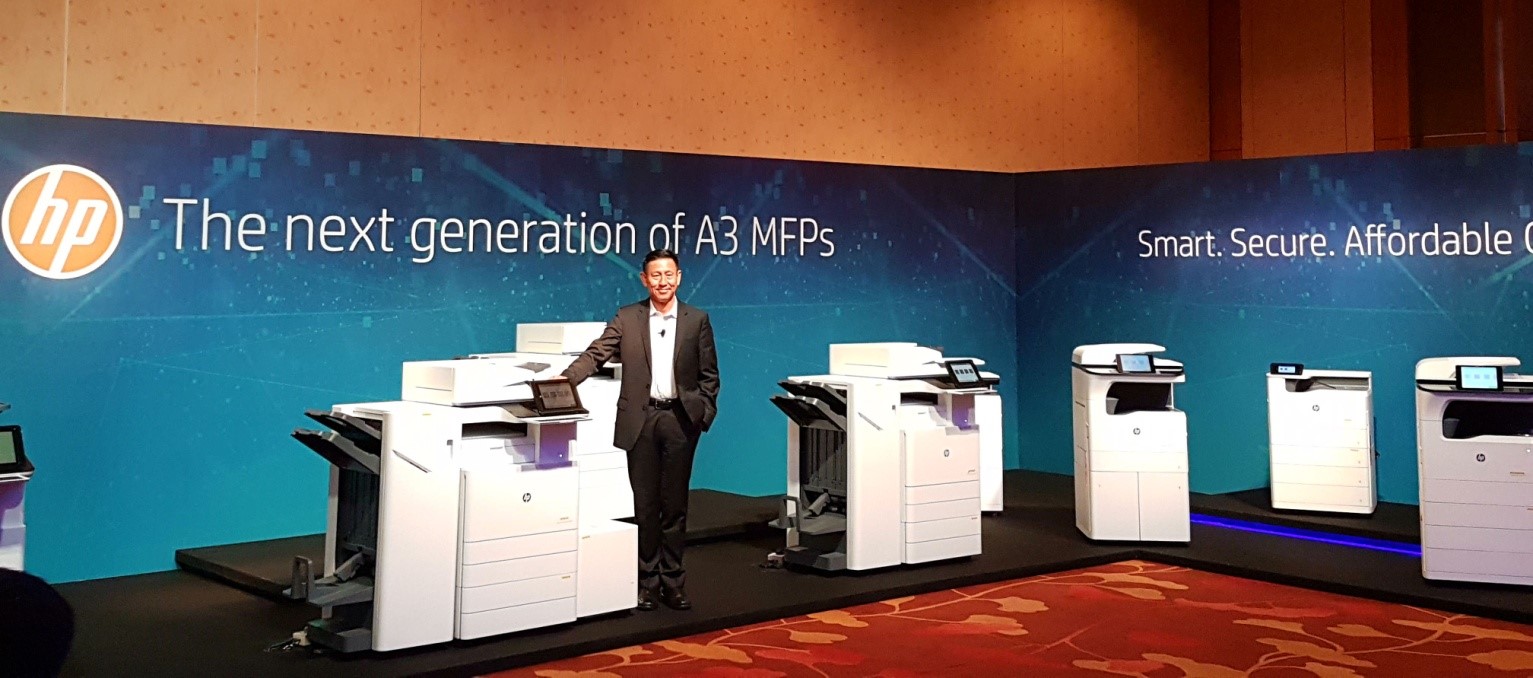On 6th June 2017, HP Inc. announced a robust line-up of next-generation A3 multifunction printers (MFPs) and HP LaserJet Enterprise 600 Series MFPs simultaneously in Southeast Asia at the IDC HP Security Forum in Singapore. The spotlight on the 54 new SKUs includes enterprise-class A3 MFPs that are designed to protect themselves in the face of growing cyber-attacks on businesses. Endpoint security is the angle that HP is playing to boot, solidified by the recent WannaCry ransomware that attacked more than 200,000 endpoints across 150 nations.
Speaker after speaker emphasized the need to include printers in the computer and network blueprint as a whole. “We are living in a new world order with connected devices and evolving attacks that often hit us when we least expect them,” said Kym Lim, Managing Director, HP Malaysia. “By integrating security in every stage of product development, we are reinventing security from protection to resilience, delivering highly secure A3 MFPs on the market, thus offering advanced security features unmatched in the marketplace,” she continued.

“Not only that but we are able to provide this with affordable colour via HP’s PageWide printing technology as well as longer device uptime via HP’s Smart Device Services technology.”
“HP sets out to reinvent the print experience by bringing the intelligence of IT into our next-generation A3 MFPs. With Smart Device Services, we are reducing service cost for partners and raising the bar in customer experience,” said Ng Tian-Chong, GM of Printing Systems, APEJ, HP.
HP has signed on-board more than 500 resellers worldwide, approximately 150 of which is in the SEA region. The new partners have been trained to leverage HP’s tools and infrastructure to provide a high-quality service experience. In addition, HP’s reseller network is extending into HP’s A3 portfolio with access to contractually optimized managed SKUs. With the arrival of the A3 portfolio, partners now have new ways to grow revenue and margins in this US$55 billion space.
Whitelisting and run-time intrusion detection
Considering that modern MFPs now behave more like PCs, and the fact that less than 2% of the world’s hundreds of millions of them, are properly secured, improving print security is a top priority for businesses. HP took great pains in ensuring that its new A3 printers are amongst the world’s most secure enterprise MFPs in the market, with enterprise-class MFPs incorporating a comprehensive suite of security features that protect devices, data and documents, creating a layered security approach needed to combat advanced attacks.
With HP Sure Start, whitelisting and run-time intrusion detection, HP enterprise-class MFPs are embedded with key security features that automatically trigger a reboot in the event of an attack or anomaly. When an attack targets the BIOs, firmware or run-time memory, these smart MFPs can generate alerts in syslog format and notify IT managers via Security Information and Event Management (SIEM) tools.
The Splunk dashboard
Going the mile, HP had also, in collaboration with Nanyang Polytechnic, become the first printing vendor to have an app created on Splunk. This app enables executives, security and IT managers to receive dashboard alerts when there are attempts to attack the network through HP printers.
“Splunk is the leading data platform for Operational Intelligence, providing insight into machine data generated from security and IT data sources, to enable rapid detection of anomalies and threats using machine-learning based analytics. Printers are a crucial component of an organization’s IT infrastructure and are often overlooked as being a potential source of vulnerabilities in a company’s network,” said Yuh Woei Tan, Country Manager, South Asia, Splunk.
Dennis Ang, Director, School of Information Technology, Nanyang Polytechnic said, “You’re only as secure as your weakest link. We don’t immediately think about printers when we plan our cyber defence strategy, but they need to be secured in an era where entire networks can be brought down by malicious hackers.
Nanyang Polytechnic is nurturing the next generation of cyber security talents through the Diploma in Cyber Security & Forensics and giving our IT students access to real world projects to hone their skill. The opportunity to collaborate with Splunk and HP has enabled our students to play a meaningful role in protecting critical operations from malicious attacks.”
Cloud-based innovation and reduced costs
HP’s portfolio of A3 MFPs – including three PageWide platforms and thirteen LaserJet platforms – benefit from the new, cloud-based proprietary service optimization platform, HP Smart Device Services (SDS). SDS delivers maximum device uptime by integrating advanced diagnostics, device specific troubleshooting and remote remediation capabilities into the industry leading MPS tool sets resellers use today.
The HP PageWide Pro devices make colour printing more affordable, while simultaneously providing best-in-class print speeds. The single and multifunction devices have print speeds ranging from 35 ppm to 60 ppm (up to 80 ppm in General Office mode). PageWide technology also claims to be more sustainable – consuming up to one-seventh the energy of competing colour laser machines in the same class while producing significantly less packaging waste associated with supplies and long life consumables.
HP LaserJet Enterprise 600 Series
Not to be sidelined, the Security Forum was also used as a launchpad to introduce the 600 Series MFPs, consisting of up to 17 SKUs with 26 available bundles ranging from 50 ppm to 75 ppm. The new devices include HP JetIntelligence cartridge technology built around a breakthrough in toner chemistry for added print quality protection.
The 600 Series is also embedded with the most advanced security features available, the ability to self-heal, automatically triggering a reboot in the event of an attack or anomaly. Additional features include built-in encryption to protect data stored on the hard drive, secure erase to remove sensitive information safely and completely, and the ability to disable ports and protocols to help prevent unauthorized access.
The all-new JetIntelligence capabilities built in starting at the toner particle level is engineered to help customers save money and time while improving carbon footprints and energy efficiencies. For example, these devices can wake up out of sleep mode to full performance in as fast as 9 seconds.
Advanced Productivity and WorkFlow
Customers can use a modern, tablet-like user interface (UI) that is now available on the recently launched HP A3 LaserJets and on the new 600 Series LaserJet devices. New UI features include a message center, improved preview, additional customization, centralized contacts and new apps designed to help streamline business processes.
Dissecting HP
For decades, HP Inc and Hewlett Packard Enterprise Company (HPE) were part of Hewlett–Packard, before they were split into two Fortune 500 organisations in 2015. HP Inc. retained the printing and PC business segments, while HPE retained the technology solutions segments.
In September 2016, HP announced its acquisition of Samsung’s printing device division, which had 6,000 employees in 50 subsidiaries around the world, and a reported 2015 revenue of US$1.8 billion. Samsung holds more than 6,500 printing-related patents, which represents the most crucial aspect of the acquisition. Besides A4 and A3 laser technology, Samsung owns also advanced mobility and cloud technology solutions that HP will implement in its products.
Over the last one year, HP and Samsung had worked together on the development of the new A3-format printing devices, culminating in the unveiling of these new suite of “next-generation” MFPs.
HP’s plans to focus on an aggressive entry into the A3 segment where it currently holds less than 5% stake, will undoubtedly grow after marrying its own and Samsung’s technologies to produce A3 laser MFPs touting advanced security, low cost per page and easy maintenance. IDC’s research shows that A3 laser MFPs account for 40% of the total page volume in offices and households globally, thus making it an attractive segment to grow in.
Having the lion’s share of market at 40% in the US$55 billion A4 MFP space, it is now well-timed for HP to pursue its determined push into the A3 MFP market, also coincidentally, valued at US$55 billion, notwithstanding that people are printing less. Beyond the howl of The Wolf, HP has to put hype into action and quickly leverage on its channel & customer network and service quality to expand into the A3 MFP market.









